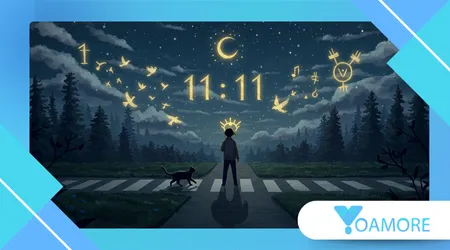Présages et prédictions : lire l'avenir à travers les signes

La fascination pour lire l'avenir à travers des signes n’a jamais disparu, même à une époque dominée par la science et la technologie.
Annonces
Les humains recherchent du sens dans les symboles, les coïncidences et les événements naturels, trouvant du réconfort dans leur potentiel prédictif.
Cet article explore la pertinence culturelle des présages, leurs fondements historiques et psychologiques, leur transformation à l’époque moderne et les réflexions éthiques entourant leur utilisation.
Il offre une vision équilibrée qui valorise la tradition tout en remettant en question la fiabilité.
Ce que vous apprendrez :
Annonces
- Comment les différentes civilisations ont interprété les présages
- Les racines psychologiques de la perception des signes
- Pourquoi les symboles façonnent encore le comportement moderne
- Réflexions éthiques sur les prédictions d'aujourd'hui
- Liens entre les lectures anciennes et la prospective moderne basée sur les données
Les présages comme codes culturels de l'humanité
Chaque culture code le sens par des signes. Dans la Rome antique, les augures étudiaient le vol des oiseaux avant les guerres ou les décisions politiques.
En Chine, les empereurs consultaient les événements naturels, comme les éclipses, pour déterminer la légitimité et l’approbation divine.
De telles traditions révèlent un point commun : lorsque les gens pratiquaient lire l'avenir à travers des signes, ils cherchaient plus que des réponses.
Ils recherchaient un sentiment de réconfort, un sentiment d’ordre dans un monde défini par l’incertitude et le risque.
La persistance de ces croyances à travers le temps démontre leur poids culturel.
Le folklore sur les chats noirs, les miroirs brisés ou les cris d’animaux inattendus continue d’influencer les décisions quotidiennes dans le monde entier, même parmi ceux qui s’identifient comme des penseurs rationnels.
+ Le rôle de TikTok dans la renaissance de la langue hawaïenne
Continuité et transformation historiques
Les premières tentatives enregistrées pour décoder les présages apparaissent en Mésopotamie, où des tablettes d'argile décrivaient des interprétations du tonnerre, des éclipses et du comportement animal.
Il ne s’agissait pas de mythes isolés ; ils faisaient partie de décisions administratives et politiques.
Les oracles grecs ont amplifié cette pratique en fournissant des conseils aux citoyens comme aux dirigeants. Leurs réponses énigmatiques ont été débattues pendant des générations, influençant les guerres et les politiques, façonnant souvent le destin de régions entières.
Au fil du temps, lire l'avenir à travers des signes je suis passé d’une pratique institutionnalisée à une spiritualité personnelle.
Alors que les États s’appuyaient moins sur la divination, les individus continuaient d’interpréter les symboles comme des forces directrices, intégrant les signes dans la vie privée et communautaire.
+ Pourquoi les chats noirs sont craints (et aimés) dans différentes cultures
La psychologie de la reconnaissance des formes

Pourquoi l'humanité est-elle toujours attirée par les présages ? Les psychologues suggèrent que les humains sont naturellement en quête de modèles.
L’identification des signaux améliorait autrefois la survie, permettant aux premières communautés de détecter les prédateurs, de suivre les saisons et d’anticiper les dangers.
Les biais cognitifs expliquent en grande partie le phénomène. Les gens éprouvent apophénie, la tendance à percevoir un sens dans des événements aléatoires. Une série de coïncidences paraît significative, même en l'absence de lien rationnel.
Des études menées par l’American Psychological Association confirment que cette quête de sens est universelle.
Pour beaucoup, lire l'avenir à travers des signes il s’agit moins de prédiction que de création de stabilité émotionnelle dans des environnements imprévisibles.
Les signes dans la vie quotidienne contemporaine
Dans un monde numérique et laïc, on pourrait croire que les signes ont disparu. Pourtant, l'interprétation symbolique prospère dans les sociétés modernes.
Les gens attribuent une signification à des nombres récurrents, à des rencontres inattendues ou à des perturbations naturelles comme des tempêtes soudaines.
Imaginez que quelqu'un remarque « 11:11 » à répétition sur les horloges pendant des semaines stressantes. Plutôt qu'une coïncidence, cela pourrait être perçu comme un rappel d'alignement ou un réconfort, renforçant ainsi la résilience émotionnelle.
Cet exemple illustre comment la pensée symbolique s’adapte aux contextes modernes.
Les chefs d’entreprise, les étudiants et les athlètes se livrent souvent à des rituels subtils ou interprètent des coïncidences inhabituelles comme des présages.
Loin de disparaître, lire l'avenir à travers des signes évolue pour répondre aux pressions quotidiennes et aux défis modernes.
Lire aussi : Comment les rêves sont interprétés comme des présages dans le monde
Données, croyances et pratiques culturelles
Les recherches continuent de montrer que la pensée symbolique joue un rôle dans les décisions d'aujourd'hui. Une enquête menée en 2022 par le Pew Research Center a révélé que 401 adultes américains sur 3 croient aux présages ou aux signes qui influencent leur vie.
| Pratiques spirituelles ou prédictives (adultes américains, 2022) | Pourcentage |
|---|---|
| Astrologie et horoscopes | 29% |
| Croyance aux présages et aux signes | 40% |
| Lectures psychiques | 19% |
Les chiffres mettent en évidence la coexistence d’une planification rationnelle et d’une interprétation symbolique.
Les gens peuvent se fier aux applications météo pour obtenir des prévisions, mais continuent d’interpréter les migrations inhabituelles d’oiseaux comme des présages saisonniers, combinant des approches à la fois rationnelles et intuitives.
Responsabilité éthique et culturelle
L'interprétation symbolique implique une responsabilité. Les présages, mal utilisés, peuvent manipuler les individus vulnérables en quête de certitude.
Dans certains contextes, les opportunistes exploitent la peur pour vendre des prédictions ou des « prophéties » financières.
Le respect des traditions culturelles exige de la sensibilité. Les communautés considèrent les pratiques symboliques comme faisant partie du patrimoine, mais les confondre avec des vérités absolues risque de porter préjudice.
Une approche réfléchie reconnaît les présages comme des histoires significatives et non comme des prévisions définitives.
Ainsi, les discussions sur lire l'avenir à travers des signes Il faut trouver un équilibre. Respecter les traditions, mais remettre en question les pratiques manipulatrices.
Préserver la continuité culturelle tout en promouvant un engagement rationnel et éthique avec des interprétations symboliques.
La technologie et le visage numérique de la prédiction
Dans le monde actuel, les algorithmes ont remplacé les augures comme interprètes de modèles cachés. Les systèmes de recommandation et l'analyse prédictive analysent de vastes ensembles de données pour suggérer des résultats.
Parfois, ces prédictions numériques ressemblent étrangement à des présages.
Les deux systèmes partagent une caractéristique essentielle : traduire la complexité en conseils. Là où les anciens augures étudiaient les oiseaux, les algorithmes traitent les clics et les comportements.
Pourtant, les humains traitent souvent ces prévisions avec la même révérence qu’ils accordaient autrefois aux oracles.
Les algorithmes prédictifs sont-ils fondamentalement différents des lire l'avenir à travers des signes? À un certain niveau, oui, car ils sont axés sur les données.
Pourtant, dans la pratique, les gens interprètent souvent les résultats algorithmiques à travers des attentes culturelles et des préjugés personnels.
Adaptations culturelles à travers le monde
La diversité mondiale enrichit le débat. Dans l'Inde rurale, les agriculteurs observent encore les migrations animales et l'activité inhabituelle des insectes pour anticiper les pluies, complétant ainsi les prévisions météorologiques modernes.
De telles pratiques soutiennent la résilience agricole.
Dans certaines régions d’Amérique du Sud, les communautés interprètent les rêves comme des avertissements ou des bénédictions, intégrant des lectures spirituelles dans les décisions collectives.
Ces traditions coexistent avec les outils numériques, prouvant que l’interprétation symbolique s’adapte plutôt que de disparaître.
Des rituels locaux à l'intuition professionnelle, les présages restent essentiels. Ils influencent les décisions dans la vie personnelle, professionnelle et l'identité culturelle, préservant ainsi lire l'avenir à travers des signes pertinent dans tous les contextes.
Une analogie pour comprendre
La vie ressemble à un fleuve qui coule vers des mers inconnues. Les présages sont comme des pierres qui créent des ondulations à sa surface, signalant les courants sous-jacents. Ils ne redirigent peut-être pas le cours du fleuve, mais ils modifient la façon dont les voyageurs interprètent leur voyage.
Cette perspective démontre à quel point les signes réconfortent et renforcent l'autonomie. Ils procurent un sentiment d'autonomie, rappelant aux individus que même en eaux troubles, des indices existent pour ceux qui sont suffisamment attentifs pour les remarquer.
L'importance de réfléchir aux présages
Réfléchir aux présages permet aux cultures de préserver leur identité et aux individus de trouver un sens à leur vie. Interpréter les signes, qu'ils soient spirituels ou psychologiques, relie l'humanité à son besoin intemporel d'ordre et de sens.
Pour explorer davantage ces dynamiques, des sources faisant autorité telles que La couverture de National Geographic sur les traditions culturelles donner un aperçu des diverses interprétations et de leur pérennité historique.
Engagement avec lire l'avenir à travers des signes met en valeur la résilience et l’imagination.
Il relie la connaissance rationnelle à la sagesse symbolique, soutenant la continuité culturelle tout en répondant aux incertitudes modernes.
Signes, science et influence sociale
L'influence sociale joue également un rôle. Lorsque les familles ou les communautés valident les lectures symboliques, les individus se sentent renforcés dans leurs croyances.
Les récits partagés transforment les interprétations personnelles en pratiques culturelles collectives.
En revanche, les environnements dédaigneux peuvent pousser les individus à séparer leurs croyances privées de leur expression publique.
Pourtant, même les sceptiques remarquent souvent des coïncidences et réfléchissent brièvement à ce qu’elles pourraient signifier.
En 2025, les sociétés continuent de négocier cette dualité, mêlant science et symbolisme.
Lire l'avenir à travers les signes Il s’agit moins d’une question d’exactitude que d’une question de sens partagé au sein de communautés dynamiques et interconnectées.
Conclusion
Explorer les présages ne se résume pas à traquer les superstitions. Il s'agit d'un héritage culturel profond et d'un mécanisme psychologique qui aide l'humanité à surmonter l'incertitude.
Respecter les traditions tout en restant critique préserve l’authenticité sans négliger la rationalité.
En substance, lire l'avenir à travers des signes incarne la quête de stabilité, de narration et d’orientation de l’humanité.
Elle continue d’inspirer la réflexion, renforçant l’importance de la mémoire culturelle dans l’élaboration des choix présents et futurs.
Les lecteurs peuvent approfondir leur compréhension en explorant les Les réflexions du Pew Research Center sur la religion et la vie publique, qui offrent des perspectives précieuses sur les systèmes de croyances et leur impact sur la société moderne.
Questions fréquemment posées
1. Les présages sont-ils des outils fiables pour la prise de décision ?
Pas entièrement. Si les signes apportent un soutien émotionnel, la plupart des décisions cruciales nécessitent une analyse fondée sur des preuves. Les présages doivent compléter l'évaluation rationnelle, et non la remplacer.
2. Pourquoi les signes restent-ils populaires dans les sociétés modernes ?
Parce qu'ils répondent à des besoins psychologiques et culturels. Même dans les environnements technologiques, les symboles sont appréciés pour leur réconfort, leur signification et leur continuité avec les traditions.
3. Les algorithmes agissent-ils comme des présages modernes ?
D'une certaine manière, oui. Les algorithmes interprètent les données en prédictions, s'apparentant à des lectures symboliques. Cependant, contrairement aux présages, ils s'appuient sur des probabilités statistiques plutôt que sur des récits culturels.
4. Comment peut-on interagir de manière responsable avec les signes ?
En respectant les traditions tout en cultivant une réflexion critique, en évitant l'exploitation commerciale, en honorant les pratiques culturelles et en considérant les présages comme des histoires riches de sens plutôt que comme des vérités absolues.
